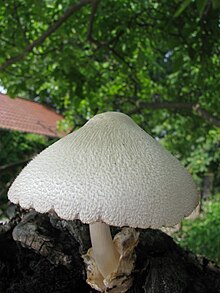Woolly Scheidling
| Woolly Scheidling | ||||||||||||
|---|---|---|---|---|---|---|---|---|---|---|---|---|

Woolly Scheidling ( Volvariella bombycina ) |
||||||||||||
| Systematics | ||||||||||||
|
||||||||||||
| Scientific name | ||||||||||||
| Volvariella bombycina | ||||||||||||
| ( Fr. ) Singer |
The woolly Scheidling ( Volvariella bombycina ) is a species of mushroom from the genus of the Scheidlinge ( Volvariella ) in the family of the roof mushroom relatives (Pluteaceae).
features
The woolly Scheidling forms large fruit bodies (hat diameter 5 to 12, in exceptional cases up to 20 centimeters) divided into hat and stem. The thin-fleshed hat is hemispherical to spherical when young and becomes conical to bell-shaped-convex with age, and also spreads out with a blunt hump when old. The hat surface is white to cream-colored and finely silky, covered with radially arranged adjacent or slightly protruding fiber flakes. The flaviceps variety is yellowish in color even at a young age. The brim of the hat protrudes over the slats. The lamellas are very crowded, they are 8 to 10 millimeters wide; they are white when young, pink to brownish mottled with age. The stem is full and brittle, it becomes 6 to 20 centimeters long and 0.7 to 2 centimeters thick, it has no ring , is thickened at the base and appears as if it has been grafted into the volva . Its surface is whitish and turns slightly ocher with age. The sack-like and membranous volva, which emerges from the Velum universale , usually extends to the middle of the stem, it is torn open, permanent and thick-skinned, whitish when young, later ocher-yellow to brownish, on the outside partly with fields. The volva is often deep in the substrate.
ecology
The woolly Scheidling is a saprobiontic to parasitic inhabitant of wood of still living, standing or already felled trees. It can appear from trunk wounds and trunk cavities a few meters high. Its fruiting bodies occasionally appear on roots and from rotten stumps. The heat-loving fungus for fructification naturally inhabits alluvial forests. But it is also reported from parks, cemeteries and on the roadsides. Its mycelium, which is said to be very resistant to cold, serves as a substrate for various hardwoods, for example maple , horse chestnut , walnut , poplar , hornbeam and other species. The maxima variety also grows on softwood. The fruiting bodies protruding individually or in small clusters appear in Central Europe from June to October.
distribution
The woolly Scheidling is common in Australia, South Africa, South America and the Holarctic . In the Holarctic, the species is widespread in the meridonal to temperate regions; it was found in the Caucasus region, southern Siberia, Japan, the USA and Canada. In Europe it occurs from southern and southeastern Europe to the Benelux countries and England, north in Fennoscandia up to the 60th, occasionally also up to the 61st parallel. In Eastern Europe, it is found in Belarus and in Russia to the Urals. In Germany the species is rare in the entire area.
meaning
The Wollige Scheidling is edible, but should be spared because of its rarity. It is potentially at risk from the removal of dying, dead, and fallen trees.
swell
- German Josef Krieglsteiner (Ed.), Andreas Gminder : Die Großpilze Baden-Württemberg . Volume 4: Mushrooms. Blattpilze II. Ulmer, Stuttgart 2003, ISBN 3-8001-3281-8 , p. 277.
- Josef Breitenbach, Fred Kränzlin (Ed.): Mushrooms of Switzerland. Contribution to knowledge of the fungal flora in Switzerland. Volume 4: Agarics. Part 2: Entolomataceae, Pluteaceae, Amanitaceae, Agaricaceae, Coprinaceae, Bolbitiaceae, Strophariaceae. Mykologia, Luzern 1995, ISBN 3-85604-040-4 .

